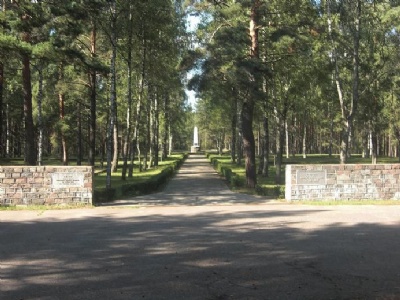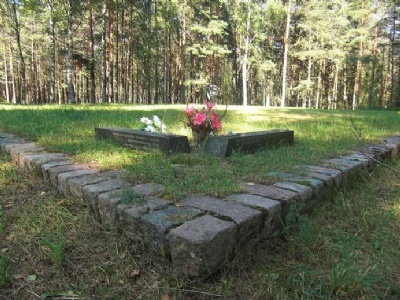Pogulanka
Just under eight kilometres northwest of Daugavpils lies Pogulanka forest and there about 15,000 Jews were murdered, mainly from the ghetto in Daugavpils. These were Jews who had been deemed unproducitve or superfluous. The Jews were forced to march to Pogulanka, undress and line up in front of a pre-dug ditch and shot by Nazi killing units assisted by Latvian voluntary nationalist units. Some executions in Pogulanka were larger than others, but the largest action took place between 8 and 10 November, 1941, when more than 11,000 Jews were killed. The Nazis had to request assistance of killing units from Riga to cope with the task.
Current status: Monument (2010).
Location: 55°54'20.94" N 26°28'21.44" E
Get there: Car.
Follow up in books: Arad, Yitzhak: Holocaust in the Soviet union (2009).




Former Western Europe called the perpetrators as Nazis while in communist Eastern Europe they were called german fascists, hitlerists or as in the former Transnistria, Killed out of Nazi ideology. Firstly, (1) the concept of (national) Socialism was problematic for the Communists. Socialism is a central concept in communism, but so it was in National Socialism, although they had different interpretations of Socialism. The perpetrators could not be linked to Socialism and therefore the communist regimes simply had to omit the concept of Socialism. That is why the perpetrators are called German fascists or hitlerists. This problem did not exist in Western Europe.
Secondly, (2) the nationality of the perpetrators was omitted because several of the Nazi collaborators in occupied countries were anti-communist, especially in the Baltic states and Ukraine. These nationalists the communist regimes had to repress because they did not fit into the political petition of a united communist front against the German fascists or hitlerists. No breeding ground for nationalism could be fomented because nationalism is a threat to the Communist basic idea. Neither could it describe the perpetrators as Germans because parts of Nazi Germany became communist East Germany after the war. This problem did not exist in Western Europe.
What could be a correct term for the perpetrators can be difficult to determine. As long as it was German Nazis who committed the crimes, everything is clear, but this was not always the case. Several of the perpetrators were Germans but not Nazis, other perpetrators were of other nationalities and not necessary shared Nazi ideas or were anti-Semites. Many of the perpetrators, especially in the Soviet Union, were nationalists who saw the Jews as representatives of communist rule. In this case, they took part in the executions for anti-Semitic reasons but sought an independent state without German interference. Those who took part in executions came from all kind of life and from different backgrounds. What united them was that they all served the Nazis’ purpose of exterminating the Jewish population of Europe for whatever reason.
There is a description that I came in contact with when have I traveled around Eastern Europe that feels right and it is the following, Killed by the Nazis and their Collaborators. It shows that the murders are based on Nazi ideology but are at the same time nationally unbound.